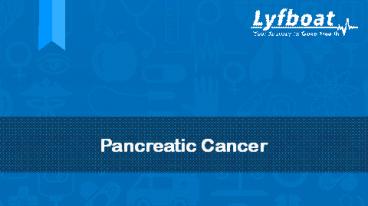Pancreatic Cancer PowerPoint PPT Presentation
Title: Pancreatic Cancer
1
Pancreatic Cancer
2
What is Pancreatic Cancer?
- The pancreas is a gland that is located in the
abdomen below stomach. It helps in the process of
digestion by secreting pancreatic juice and also
helps in regulating blood glucose levels.
Pancreatic cancer refers to cancer affecting the
pancreas, the cancer in pancreas could be benign
(does not spread) or malignant (spreading) in
nature. - Pancreatic cancer does not cause much signs and
symptoms when you do get symptoms, they are
often vague or you may not notice them. This
makes it hard to diagnose cancer at an early
stage. However, once you have been diagnosed with
the problem, your doctor will assess your current
health situation and will learn more about your
previous illness as well. After a thorough
examination and evaluation, your doctor will
choose between surgery, radiation or chemotherapy
or a combination of one or more to help you
recover fast.
3
Before the Procedure
- To diagnose pancreatic cancer, certain diagnostic
tests will be done to find the stage and cause of
it. Moreover, your doctor may ask about your
medical history to know more about your symptoms
and other possible risk factors. Since pancreatic
cancer does not cause much signs and symptoms at
early stage, later stages cause symptoms like
weight loss, loss of appetite, belly or back
pain, liver enlargement, etc. The recommended
tests are abdominal ultrasound, Endoscopic
ultrasound, MRI, biopsy, PET scan, blood tests,
etc.
4
How it is performed?
5
How It Is Performed?
- If youve been diagnosed with pancreatic cancer,
then different treatment options will be
discussed with you depending on the type
and stage of the cancer and other factors,
treatment options for people with pancreatic
cancer can include - Surgery Surgery is done to remove the affected
part of the pancreas. If a cancer has not
metastasized (spread), it is possible to
completely cure a patient by surgically removing
the cancer from the body. Different surgical
procedures are - Whipple procedure (most common in cancers of the
head of the pancreas) The pancreas head and
sometimes the entire organ is removed along with
a portion of the stomach, lymph nodes, and other
tissue. The procedure is complex and risky with
complications such as infections, bleeding, and
stomach problems.
6
Contd..
- Distal pancreatectomy The tail of pancreas is
removed, and sometimes part of the main organ
along with the spleen. This procedure is usually
used to treat islet cell or neuroendocrine
tumours - Total pancreatectomy The entire pancreas is
removed. Although you can live without a
pancreas, but you will be diabetic for life long
as your body no longer produces insulin - Radiation Radiation treatment, also known as
radiotherapy, destroys cancerous cells by
focusing high-energy rays on the cancer cells.
This causes damage to the molecules that make up
the cancer cells. Radiotherapy can be used as a
standalone treatment to shrink a tumour or
destroy cancer cells, and it is also used in
combination with other cancer treatments.
Radiation treatments for pancreatic cancer are
usually given 5 days a week for 5 to 6 weeks.
7
Contd..
- Chemotherapy Chemotherapy is generally used to
treat cancer that has spread or metastasized.
Chemotherapy uses specially designed drugs which
are delivered into the body through various
means, the drug has the potential to identify the
cancerous cells and to isolate the non-cancerous
cells, and this is made possible because the
medicines travel throughout the body. Treatment
occurs in cycles so the body has time to heal
between doses. This is also done after the
surgery to reduce the risk of recurrence of
pancreatic cancer.
8
Recovery
- Pancreatic cancer has some common side effects
like hair loss, nausea, fatigue, etc. The patient
may become weak and feel pain in the treated
area, which will heal and recover with time.
After the treatment you will have your follow-up
appointments. Where the doctor will see how you
are recovering. During these visits, your doctors
will try to learn more about any discomforts that
you might be facing. It is paramount to follow
the instructions of your doctor and stick to the
advised diet and regime.
9
Potential Risks
Pancreatic Cancer Treatment is an invasive
procedure, so there are chances of wound
infections, excessive bleeding or other
complications in the treatment area.
10
Know More About Transurethral Resection of the
prostate Visit us at https//www.lyfboat.com/pro
cedures/pancreatic-cancer/
- 1-844-LYFBOAT
- www.lyfboat.com
- www.facebook.com/lyfboat
- www.twitter.com/lyfboat

